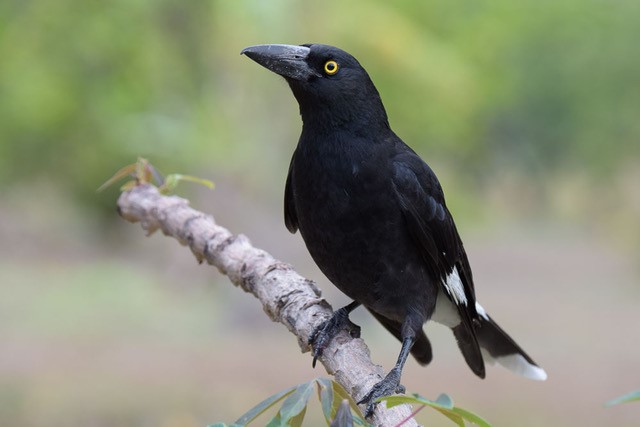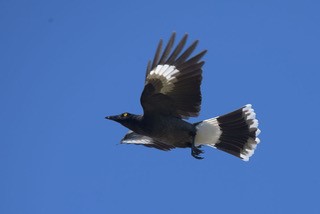Over the last few weeks, increasing numbers of Pied Currawongs, Strepera graculina, have arrived in Paluma. The onomatopoeic name currawong reflects the liquid, ringing tone of their call, heard all day throughout the village.

The currawong is a large, (42-50 cm long), handsome, black and white bird, with yellow eyes and a lilting, liquid warbling call. But do not be beguiled by the good looks and melodious carolling. Beneath the beauty lies a rapacious nature. Currawongs plunder the nests and feast on the chicks of other birds. The cruel beak says it all.

Currawongs are similar in appearance to magpies and butcher birds, and were once known as crow shrikes or bell magpies. They are found throughout eastern Australia from North Queensland to Victoria in diverse habitats including woodlands, coastal to alpine forests, rain-forests, scrublands and farmlands. They often form large flocks and are seasonally nomadic, ranging over large distances. In the breeding season, from July to January they are mostly seen alone, in pairs or in small family groups.
They tend to move into Paluma from the west as the weather becomes cooler. Sometimes a flock of fifty and more will move into the area. Today, I disturbed a gang of seven or eight on the roadside plotting their next raid.
Pied currawongs’ diet includes small lizards, insects, mice, caterpillars and berries. They also take large numbers of small and young birds. Larger prey, up to the size of a young possum can be taken and birds will sometimes hunt as a group. Prey may be stored in a tree fork or crack to be eaten later. It has been reported that pied currawongs eat more vertebrate material during the spring breeding season than they do during autumn and winter when berries are available. A pair may kill about 40 broods of small birds (up to 2 kg) to raise one brood of their own.
Raising young is a joint effort. Both sexes gather the material, sticks, grass and other soft vegetation, for the bowl-shaped nest which the female builds high in a tree fork. She incubates the eggs while he feeds her. The male supplies food to the female for the first week after the chicks hatch and she feeds them. Incubation time is 21 days and there are usually three chicks.
The dishes and trays of fruit put out by residents for the honey-eaters, rifle birds and other small birds have become fair game for the currawongs who swoop in, terrorising the other birds and taking all the food. They seem to be afraid of humans however and fly off as soon one appears. Perhaps they have a collective memory of being shot at or stoned by people! It was amusing, and surprising to see therefore, two rainbow lorikeets at my bird-feeder yesterday driving off a currawong. The attack was quite vicious with lots of pecking and screeching until the bigger bird retreated.
It will be no surprise to know that pied currawongs are not on the endangered species list: on the contrary, their numbers are increasing. They have adapted well to living in urban areas and their growing numbers have been implicated in the decline of smaller bird species.
Some information sourced from Google entries from Australian Museum and Birdlife
Text by Colwyn Campbell; Photos by Brian O’Leary
